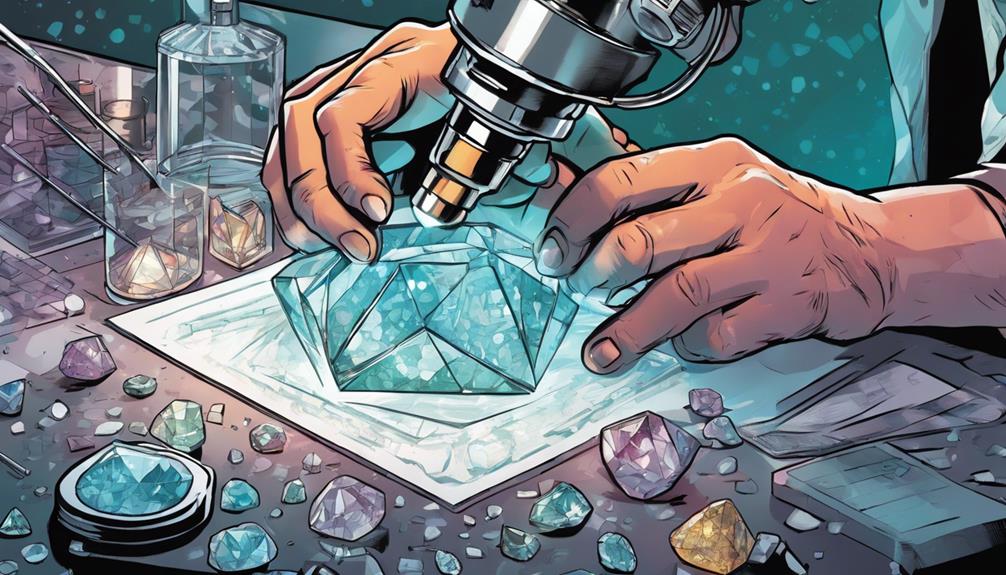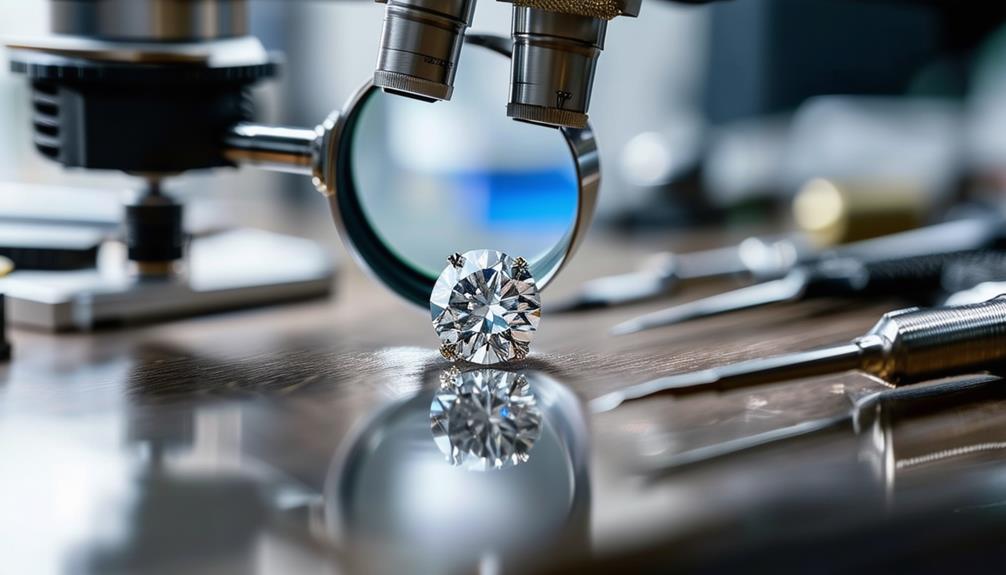Article Contents
To assess the quality of lab-grown diamonds, it is essential to seek certifications from reputable organisations such as the Gemological Institute of America (GIA) or the International Gemological Institute (IGI). These certifications confirm the diamond meets high standards.
Focus on the cut and colour; a precise cut enhances the diamond's brilliance, and a high colour grade increases its luminosity. Evaluate clarity and carat using specialised tools, as higher clarity and optimal carat contribute to the diamond's overall value.
Verify the diamond's origins to ensure ethical production. Employ advanced techniques such as spectroscopy and microscopic analysis to confirm the diamond's authenticity and quality. Each of these methods provides a comprehensive approach to accurately determining the value of a lab-grown diamond.
Key Points
- Ensure you obtain certifications from reputable organisations such as the Gemological Institute of America (GIA) or the International Gemological Institute (IGI) to verify quality and adherence to ethical standards.
- Evaluate the cut of the diamond, as a top-quality cut enhances both brilliance and sparkle, crucial features of an aesthetically pleasing diamond.
- Inspect clarity using high-resolution digital microscopy, which can uncover any inclusions or imperfections that may affect the diamond's appearance.
- Verify the diamond's ethical origin and traceability to ensure it meets responsible sourcing standards.
- Utilise advanced analytical techniques like spectroscopy and UV fluorescence to examine the diamond's chemical properties and growth characteristics, ensuring its authenticity and quality.
Certification Verification
To ensure the quality and authenticity of lab-grown diamonds, it is essential to obtain certifications from reputable organisations such as the GIA or IGI. These certifications confirm that each diamond adheres to high standards of quality and ethical production, acting as a reliable indicator of the gem's value and integrity.
For buyers prioritising authenticity and detailed verification, consulting with established jewellers and seeking expert advice is crucial. These experts use specialised tools like loupes or microscopes to meticulously inspect the diamonds for any minor imperfections that are not visible to the naked eye.
It is important to verify that the details on the certification match the actual characteristics of the diamond. This step ensures the accuracy of the diamond's described attributes and safeguards your investment by preventing any discrepancies that could impact the diamond's value.
Assessing Cut and Colour
Assessing the cut and colour of lab-grown diamonds is crucial for determining their quality and visual impact. The cut of a diamond significantly influences its brilliance and sparkle by affecting how light reflects within the stone. A well-executed cut ensures proper symmetry and balance, enhancing the diamond's brightness and fire. Lab-grown diamonds that are expertly cut display exceptional light performance, captivating observers with their luminosity.
Colour is another critical feature in lab-grown diamonds, affecting their overall attractiveness. These diamonds typically appear near-colourless to colourless, comparable to the top classifications of the GIA colour scale. Precision cutting not only shapes the diamond but can also accentuate its colour quality, providing a clear and vivid appearance that competes with natural diamonds. Choosing a lab-grown diamond that excels in both cut and colour ensures a gem with remarkable sparkle and visual clarity, offering an attractive option for those prioritising both aesthetics and value in their jewellery choices.
Analysis of Clarity and Carat
In the realm of lab-grown diamonds, assessing clarity is crucial as it reflects the presence of inclusions and blemishes, which can affect the stone's appearance and value.
Equally important is the consideration of carat weight, as it not only contributes to the diamond's size but also significantly impacts its market price.
These aspects are critical for gauging the overall quality and appeal of lab-grown diamonds, thereby aiding consumers in making well-informed purchasing choices.
Assessing Clarity Grades
Assessing the clarity grades of lab-grown diamonds is essential to determine their quality and aesthetic characteristics. Key techniques such as identifying inclusions and enhancing clarity are crucial. State-of-the-art tools like digital microscopy provide detailed views of internal structures, improving the accuracy of quality assessment. Similarly, fluorescence analysis is important for evaluating the optical properties affected by inclusions.
| Technique | Application | Benefit |
|---|---|---|
| Inclusion Identification | Detecting internal flaws | Improves assessment of purity |
| Clarity Enhancement | Enhancing visual appearance | Increases market value |
| Digital Microscopy | Detailed internal examination | Ensures accurate quality assessment |
| Fluorescence Analysis | Analysing optical characteristics | Assists in precise grading |
These methods ensure that each lab-grown diamond is thoroughly evaluated for flaws, confirming its attractiveness and worth.
Understanding Carat Implications
Carat weight significantly affects both the size and perceived quality of lab-grown diamonds. It is crucial to balance these aspects to maximise the diamond's value.
Lab-grown diamonds come in various carat weights, enabling buyers to choose one that aligns with their aesthetic preferences and budget.
It is important to consider both clarity and carat weight when selecting a diamond, ensuring that the chosen piece reflects the wearer's individuality and enhances the overall design of the jewellery.
This thoughtful selection process leads to informed decisions, making the pursuit of the ideal lab-grown diamond both fulfilling and efficient.
Origin and Traceability
In exploring lab-grown diamonds, it's crucial to verify their origins and traceability. Certificates confirming their lab-based creation enhance consumer trust by verifying both ethical production and authenticity.
Moreover, rigorous traceability methods and ethical sourcing standards ensure the sustainability and ethical integrity of these diamonds, supporting informed consumer choices and confidence in the ethical production of these stones.
Certificate of Origin
Certification of origin for lab-grown diamonds is crucial for ensuring their traceability and verifying their production as ethical and sustainable. This certification process meticulously records the origins of each diamond, offering buyers assurance of authenticity and transparency.
The certificates provide detailed information about the diamond's growth process, emphasising adherence to ethical sourcing and environmental protection. Such credentials confirm that these diamonds are conflict-free and meet strict quality standards.
Traceability Technology
Traceability technology for lab-grown diamonds uses blockchain to track each diamond's origin and manufacturing process. This system ensures transparency and adherence to ethical standards, offering a secure and reliable record of a diamond's history from production to point of sale.
Consumers can access comprehensive details about the diamond's characteristics and the eco-friendly methods used in its creation. By verifying the origin, the technology not only certifies the diamond's authenticity but also supports ethical practices in the diamond industry.
Equipped with this information, consumers are better positioned to make responsible choices, enhancing both trust and ethical responsibility in the diamond market.
Ethical Sourcing Practices
Leveraging blockchain technology, ethical sourcing practices for lab-grown diamonds ensure transparency regarding their origins and production techniques. These diamonds are verifiably produced in controlled settings, eliminating the environmental degradation associated with traditional mining.
Such transparency not only meets consumer demand for ethical products but also enhances their ability to make informed choices based on the sustainable and ethical attributes of each diamond. Companies provide detailed insights into their low-impact production methods, increasing consumer trust and supporting environmentally responsible purchasing decisions.
Ethical sourcing in this context extends beyond mere aesthetics or value; it embodies thoughtful consumerism and environmental responsibility in the luxury sector.
Sustainability Practices
Lab-grown diamonds offer a sustainable alternative to traditional diamonds by significantly reducing the environmental degradation associated with extensive mining practices. These diamonds support ethical sourcing and environmental responsibility, aligning with contemporary values. The production of lab-grown diamonds has a minimal impact on natural habitats and helps to lower carbon emissions, positioning them as an environmentally friendly choice within the gemstone industry.
| Aspect | Traditional Diamonds | Lab-Grown Diamonds |
|---|---|---|
| Environmental Impact | High due to mining | Minimal |
| Ethical Sourcing | Often questionable | Highly controlled |
| Carbon Footprint | Significant | Reduced |
| Habitat Destruction | Extensive | Minimal |
Choosing lab-grown diamonds not only reflects a commitment to environmental conservation but also addresses ethical concerns in diamond sourcing. Enhanced traceability technologies ensure the origins of lab-grown diamonds are well-documented, promoting transparency. Opting for lab-grown diamonds represents a conscious decision to support sustainable luxury, making a positive statement for ecological stewardship and a responsible future.
Advanced Inspection Techniques

Advanced inspection techniques are essential for ensuring the quality and authenticity of lab-grown diamonds. Techniques such as spectroscopy analysis allow experts to determine the precise chemical composition of these diamonds, confirming their similarity to natural diamonds. This method provides a strong scientific basis for verifying the elemental structure of the diamonds, which is crucial for buyers seeking reassurance in their quality and origin.
Furthermore, microscopic examination is used to identify any inclusions or imperfections that could impact the clarity and value of the diamonds. This thorough inspection is vital for buyers who place importance on flawlessness in their gem choices.
Additional methods, like Glow Mapping and UV fluorescence, play a key role in distinguishing lab-grown diamonds from natural ones. Glow Mapping exposes distinct growth patterns, while UV fluorescence aids in recognising characteristics specific to lab-made diamonds. These techniques are essential for establishing the identity and quality of each diamond, thus giving buyers confidence in their purchases.
By utilising these advanced and stringent inspection techniques, the integrity and value of lab-grown diamonds are effectively confirmed, providing buyers with trust and satisfaction in their investment.
Frequently Asked Questions
How to Spot Lab-Created Diamonds?
To differentiate lab-grown diamonds from natural ones, you should evaluate their refractive properties and carefully examine them for any imperfections. Seek advice from a qualified gemmologist and confirm that the diamonds come with reputable certification, guaranteeing their authenticity and giving you peace of mind when making a purchase.
What is the most common gemmological technique for identifying lab-grown diamonds?
The main gemological method for distinguishing lab-grown diamonds from natural ones is spectroscopy. This technique involves using spectral analysis to examine the diamond's atomic structure, which helps to confirm its origin with accuracy and precision.
Can an expert determine if a diamond has been grown in a laboratory?
Yes, experts with specific skills and advanced equipment can accurately determine whether a diamond is created in a laboratory. Certificates that provide information about the origin and quality of diamonds are essential in helping consumers to make well-informed decisions based on trustworthy information.
How are lab-grown diamonds identified?
Lab-grown diamonds are identified by engraving particular information on their edge, such as their source and certification codes, to enable independent confirmation of their genuineness and quality.
Conclusion
In conclusion, evaluating lab-grown diamonds through methods such as certification verification, advanced inspection techniques, and assessing sustainability practices ensures their high quality and ethical value.
Significantly, over 70% of younger consumers prioritise ethical sourcing when purchasing diamonds, emphasising the importance of traceability in today's jewellery market.
This trend shows a notable move towards responsible consumption, combining luxury with sustainability in the gemstone industry.

